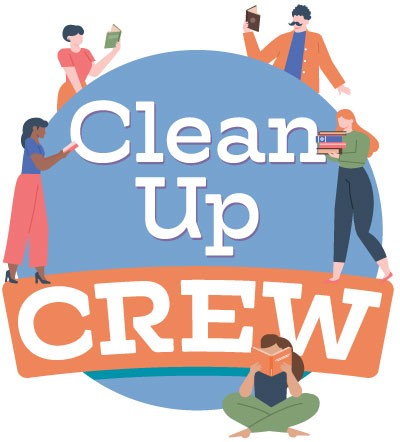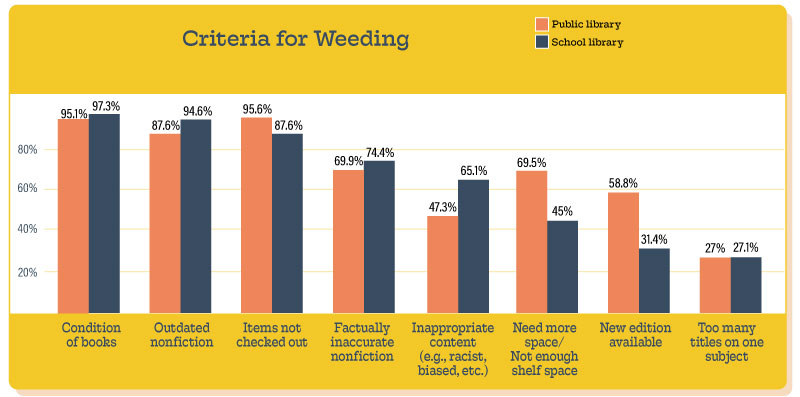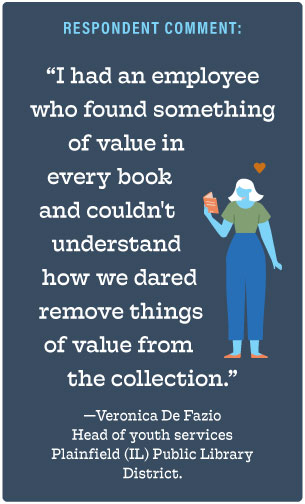When Weeding Books, Librarians Are Attending to Inclusion and Diversity, SLJ Survey Shows
Librarians are paying more attention to unconscious racial bias, inclusion, and diversity issues when culling titles and considering collection development, according to School Library Journal's recent survey.
SLJ’s CHILDREN’S/YA COLLECTION DEVELOPMENT AND WEEDING SURVEY
 |
SLJ design. Characters by Veronika Oliinyk/Getty Images |
The data is in, and it shows that librarians across the country are changing the criteria they use to weed books, paying more attention to unconscious racial bias, inclusion, and diversity issues when culling titles.
They’re also focusing more on diverse reads and #OwnVoices books when purchasing new titles and making collection development choices, according to SLJ’s Children’s/YA Collection Development and Weeding Survey. The survey included 784 responses from librarians who work at both public libraries and schools.
Librarians had a lot to say about their current weeding and buying criteria.
“I am conscious about making my collection equitable and inclusive,” Becca Rutkowski, youth collection librarian at Mount Prospect (IL) Public Library, wrote in a survey comment. “I want to buy books that represent my diverse community.”
“As I have become more experienced and better know my students’ and curricular needs, I try to focus on bringing diverse viewpoints to our collection,” said Maryalice Bond, a school librarian at Boiling Springs (PA) High School. “I look for titles that are relevant to my students’ world [and] also provide them with the ability to understand or experience things outside of their own lives.”
What else are librarians buying? With millions of students learning from home, many public librarians also invested in books for parents about how to homeschool children, according to survey comments. Sixty-three percent of public libraries reported that their 2020 children’s and YA purchasing reflected the needs of remote learners and homeschooling families. Public librarians also purchased more digital materials and increased their selection of STEM-focused supplies as well as nonfiction.
“We spent a significant amount on materials for weekly take-home science kits,” said youth services librarian Mary Neuman at Asotin County (WA) Library.
In 2020, both school and public librarians bought more fiction than nonfiction in all formats: print books, ebooks, and downloadable audiobooks. Public librarians reported that picture books comprised 30 percent of all book purchases—more than any other category. Middle grade was the next largest category, accounting for 24 percent.
Individual school librarians have a lot of control over purchasing decisions: In 99 percent of schools, print book selections are made by the librarian at the school level. However, ebook and audiobook selections more often come from higher up. At 23 percent of schools, those purchasing choices happen at the district level.

Putting student interests first
In addition to focusing on diverse and #OwnVoices books, librarians use a range of criteria when deciding what to buy. For many, student interest is key.
“The most important thing that I consider…is whether or not I think my students will want to read the books,” said Anne Link, librarian at Bristol (MO) Elementary School.
Alison Love, librarian at Magnolia (TX) Elementary School, considers “student interest, state standards, cultural significance, representation, campus growth needs (adding PK and bilingual titles), and replacement of out-of-date or inaccurate titles.”
“The wants and needs of the student population guide my decision of collection development,” said Lisa Buford, librarian at Dwight Middle School Library in San Antonio, TX. “I also use the curriculum to guide some nonfiction decisions, such as the 300s and 500s Dewey sections.”
Public libraries are more likely to have newer children’s and YA collections than school libraries, according to the survey. Public libraries estimate that 26.2 percent of their collection was published in the last two years, compared to some 16.5 percent of school collections. Elementary schools reported the lowest percentage of books published within two years (13.2 percent) while the high school average is the highest (23.6 percent).
Librarians: Share Your Best (Worst?) Photos of Weeded Books
Nearly half of public librarians who responded (47 percent) report weeding their collections more during the pandemic. Twenty-one percent weeded less, and 29 percent estimated the same amount as before. Some are weeding less because their circulation numbers are off due to building closures. Others are weeding more because they have additional time.
At school libraries, 32 percent are weeding more; 33 percent are weeding less; and 27 percent are weeding the same amount as before. Sharon Zoumbaris, librarian at Westwood Hills (VA) Elementary School, is among those who have been less active: “I have less access to the library, because it is being used for other purposes.”
Others have been tied up with other responsibilities during this challenging year. Love said, “I spend too much time on student devices to weed the way I usually do.”
 Weeding with purpose
Weeding with purpose
While deciding what to weed, librarians’ three most common criteria are: condition of books, outdated nonfiction, and items not being checked out, according to the survey. Other criteria include factually inaccurate nonfiction, inappropriate content, and need for more space.
“I have weeded what are termed classic novels, and some thought I should keep them,” wrote Dawn Baughman, librarian at Jason Lee Middle School in Tacoma, WA. “My students were not checking them out.”
Veronica De Fazio, head of youth services at Plainfield (IL) Public Library District, wrote, “We used to keep almost everything we had on certain subjects in order to support the school curriculum. Over the past five years, the schools no longer assign those perennial topics. We don’t need as many books in those areas anymore.”
About 55 percent of respondents use the CREW method, developed by the Texas Library Association. CREW stands for Continuous Review, Evaluation, and Weeding, and the strategy poses six general criteria for considering weeding an item.
Some school librarians turn to their students for help when deciding what to keep, bearing in mind their own potential biases. “I have found that it’s difficult to get rid of books that I love,” said Shelly Lee, a school librarian at Central Junior High School in Moore, OK. “But that does not mean the students love them. They may be outdated. I ask a student to read it and report back to me. If the student liked the book, I keep it awhile longer. If not, I weed it.”
Pushback and close calls
Public and school libraries’ weeding criteria differ in some ways, the survey showed. "Inappropriate" content is weeded more often in school libraries. Co-workers and patrons are the most likely to deliver pushback on weeding decisions in public libraries, while faculty is the number one opponent to weeding certain titles in schools.
“It took me eight years to get my administrator to let me weed without them personally reviewing and discussing each title,” wrote Jennifer Wharton, a librarian at Matheson Memorial Library in Elkhorn, WI. “Arguments included ‘history doesn’t change’ and ‘but it has color photographs’ and ‘it’s like new!’”
Amber Gladle, a librarian at Morristown (NY) Central School, said, “My items need to be board approved before weeding them. Some have been purchased in honor of a past employee, but they have never circulated, so it gets a bit difficult to weed some items.”
At Wilson Middle School in San Diego, CA, “Some believe that all books should be kept no matter whether they fit our mission,” said school librarian Sabrina McNeill.
At Thorpe Gordon Elementary in Jefferson City, MO, “Citizens don’t understand why we are eliminating tax-payer funded materials,” says library media specialist Melanie Thompson.
Respondents shared noteworthy situations where they struggled with a weeding decision.
“I’m currently thinking about how much of Dr. Seuss to weed,” wrote elementary school librarian Laura Gladding at Moses Brown School in Providence, RI. “Many teachers love his books from their childhood, but the books do not get checked out and some have racist content. I’ve deleted the worst offenders and am in conversation with our Diversity committee regarding a policy.”
School librarian Amy Lyons was leaning toward chucking Anna Karenina, but then something surprising happened. “Despite its literary acclaim…the novel is large, and generally not widely circulated in high school,” wrote Lyons, who works at Westport Middle School in Louisville, KY. “However, I kept it, because a box office movie was due to be released in a few months, and experience had taught me that multiple students request a title when its cinematic iteration is released. I was really skeptical of my decision, but when the movie came out, even I was surprised that I could not keep Anna Karenina on the shelf.”
Rachel Van Dyk, librarian at Valley Christian Schools in Cerritos, CA, developed her own criteria. “If I’m unsure about weeding a title, I note the date, put that inside the book, leave the book in the catalog, but place it behind my desk,” she says. “If no one requests it or asks about it after three to four years, I discard it.”
Those kind of discard decisions are needed to build more equi-table collections. “I am growing my graphic novel section and looking for titles with diverse characters,” said Amanda Kovach, media specialist at Symmes Elementary School in Riverview, FL.
Kristen Thomas Clark’s top criteria when buying for Media Providence Friends School in Media, PA, are “quality books that are informative or provide windows and mirrors for my students.”
|
About the Survey: The survey link was emailed in early February to approximately 13,000 school librarians and 10,000 school |
Download the Collection Development and Weeding Survey Summary 2021
Melanie Kletter is a teacher and freelance writer in New York City.
RELATED
The job outlook in 2030: Librarians will be in demand
The job outlook in 2030: Librarians will be in demand
ALREADY A SUBSCRIBER? LOG IN
We are currently offering this content for free. Sign up now to activate your personal profile, where you can save articles for future viewing






Add Comment :-
Be the first reader to comment.
Comment Policy:
Comment should not be empty !!!